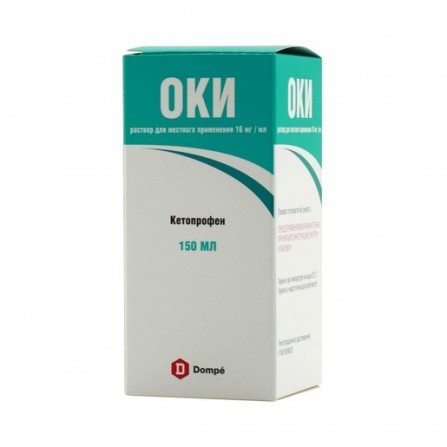Oki solution for local use 160mg 10ml bottle 150ml
Condition: New product
998 Items
Rating:
Be the first to write a review!

More info
Active ingredients
Ketoprofen
Release form
Solution
Composition
1 ml of solution contains 16 mg of ketoprofen lysine salt. The ingredients include: glycerol, as a preservative and to give a thicker consistency, ethanol, as a preservative, methyl parahydroxybenzoate, as a preservative, mint flavor, menthol, to give a mint flavor and a slight cooling effect, sodium saccharate, as a sweetener , brilliant green, as a dye, sodium dihydrogen phosphate - emulsifier, purified water.
Pharmacological effect
Pharmacological action - anti-inflammatory, antipyretic, analgesic. The mechanism of anti-inflammatory action is associated with a violation of the synthesis of prostanoids (major inflammatory mediators) from arachidonic acid by blocking type I and type II cyclooxygenase. In addition, the drug suppresses the production of leukotrienes with chemotactic effects. The antiradikinin activity is also present in the spectrum of action of the drug. It stabilizes lysosomal membranes and delays the release of enzymes from them that contribute to the destruction of tissue in chronic inflammation. Reduces the activity of cytokines, inhibits the activity of neutrophils (cytokines, especially interleukin 1 and tumor necrosis factor, released when neutrophils are activated, play a crucial role in inflammatory tissue damage). The analgesic effect of OCI is determined by its direct and indirect effect on pain receptors at the synapse level and in CNS . Indirect peripheral antinociceptive action is associated, firstly, with the inhibition of the synthesis of PGs, which increase the sensitivity of free nerve endings to stimuli (PGs also enhance the effect of other inflammatory mediators). Secondly, an important component of the pronounced peripheral analgesic effect of OKA is its bradykinin activity (bradykinin is one of the most powerful endogenous substances that contribute to the development of pain). OCI also has a direct effect on pain receptors, consisting in the depolarization of ion channels, due to which a quick effect on the pain response is carried out. The central action of the OKA is determined by the change in the configuration of the G-protein located on the postsynaptic membrane of neurons.Thus, the afferent signal of pain is reduced.
Pharmacokinetics
Suction. Assigned inside, ketoprofen is rapidly and completely absorbed from the gastrointestinal tract, its bioavailability is about 80%. Cmax in the plasma when taken orally is noted in 0.5–2 h, its value directly depends on the dose taken; after rectal administration, Tmax is 45–60 min. Ketoprofen CSS is achieved 24 hours after the beginning of its regular intake. Distribution. Up to 99% of absorbed ketoprofen binds to plasma proteins, mainly albumin. Vd - 0.1–0.2 l / kg. It easily passes through histohematogenous barriers and is distributed in tissues and organs. Ketoprofen penetrates well into the synovial fluid and connective tissue. Although the concentration of ketoprofen in synovial fluid is slightly lower than in plasma, it is more stable (lasts up to 30 hours). Metabolism. Ketoprofen is mainly metabolized in the liver where it undergoes glucuronidation to form esters with glucuronic acid. After using 160 mg of ketoprofen lysine salt in the dosage form, the solution for topical administration is low plasma concentration of ketoprofen - less than 400 ng / ml - and therefore not sufficient for pronounced systemic pharmacological action.
Indications
Symptomatic treatment of inflammatory diseases of the upper respiratory tract and oral cavity: sore throat, laryngitis, pharyngitis, tonsillitis, stomatitis, gingivitis, glossitis, aphtha, periodontal disease, chronic paradontosis, and dental manipulation (as an analgesic agent).
Contraindications
Hypersensitivity (including to other NSAIDs); aspirin asthma. With care: peptic ulcer of the stomach and duodenum (exacerbation); ulcerative colitis (exacerbation); Crohn's disease; diverticulitis; peptic ulcer; hemophilia and other bleeding disorders; chronic renal failure; childhood (up to 6 years); pregnancy (III trimester); lactation period.
Use during pregnancy and lactation
Like other NSAIDs, OKA should not be used in the third trimester of pregnancy. Use of the drug in the I and II trimester should be carefully monitored by the attending physician. Breastfeeding when using the drug should be discontinued.
Dosage and administration
For 2 rinses per day, 10 ml of solution OKA (5 injections) for 1 dose.The solution of 5 injections should be diluted in a cup attached to the packaging, half filled with drinking water. When pressing the dispenser-injector located in the upper part of the vial, the patient receives 1 injection - 2 ml of OKA solution. Accidental ingestion of the rinse solution does not lead to serious consequences, since a single dose for rinsing contains 160 mg of ketoprofen lysine salt, which corresponds to the dose intended for oral administration. Teens over 12 years old should use no more than 3 injections per cup
Side effects
Allergic reactions. Systemic side effects may occur if the drug is swallowed.
Overdose
Currently, no cases of overdose with OCI have been reported. Treatment: in case of overdose, carry out the treatment prescribed in case of poisoning with NSAIDs
Interaction with other drugs
No interactions detected
special instructions
Prolonged use of external drugs may cause sensitization. In this case, you should stop using the drug and find adequate treatment methods.




